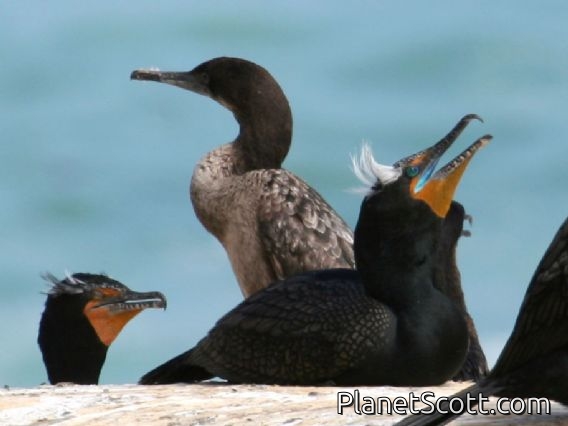Double-crested Cormorant (Nannopterum auritum)


About Double-crested Cormorant (Nannopterum auritum)
- Kingdom: Animals
- Phylum: Chordates
- Class: Birds
- Order: Pelicans
- Family: Cormorants
The double-crested cormorant is a member of the cormorant family of water birds. It is found near rivers and lakes and in coastal areas and is widely distributed across North America, from the Aleutian Islands in Alaska down to Florida and Mexico. Measuring 70–90 cm (28–35 in) in length, it is entirely black except for a bare patch of orange-yellow facial skin and some extra plumage that it exhibits in the breeding season when it grows a double crest in which black feathers are mingled with white. Five subspecies are recognized. It mainly eats fish and hunts by swimming and diving. Its feathers, like all cormorants, are not waterproof, and it must dry them out after spending time in the water. Once threatened by the use of DDT, the numbers of this bird have increased markedly in recent years.
Source: Wikipedia
Trips
Visits
-
2006-02-16
Lake Merced , United States of America -
2006-04-19
Candlestick Park, United States of America -
2006-06-03
Farallones Marine Sanctuary, United States of America -
2007-01-01
Candlestick Park, United States of America -
2007-04-07
Torrey Pines State Reserve, United States of America -
2007-06-14
Cape May National Wildlife Refuge - Deleware Bay, United States of America -
2008-02-17
San Jose del Cabo - Estuary, Mexico -
2008-08-25
Elgin - Bluff Spring Fen, United States of America -
2009-01-22
Cay Caulker, Belize -
2009-04-05
East Wash, United States of America -
2009-05-05
Elgin - Bluff Spring Fen, United States of America -
2009-10-01
Crissy Field, United States of America -
2009-11-22
Palo Alto Baylands, United States of America -
2009-11-29
Heron's Head Park, United States of America -
2010-01-03
Sacramento National Wildlife Refuge, United States of America -
2010-05-17
Farallones Marine Sanctuary, United States of America -
2010-06-21
Cape May Point State Park, United States of America -
2012-05-20
Pyramid Lake, United States of America -
2012-07-10
Chase Lake NWR, United States of America -
2012-07-10
I-94 Rest Stop, United States of America -
2012-08-12
Coyote Point County Park--harbor and marsh, United States of America -
2012-09-07
Heron's Head Park, United States of America -
2012-09-23
Heron's Head Park, United States of America -
2012-09-30
Golden Gate Park - Stow Lake, United States of America -
2012-12-02
Lake Merced , United States of America -
2012-12-13
Heron's Head Park, United States of America -
2013-03-17
Lake Merced , United States of America -
2013-03-23
Coyote Point County Park--harbor and marsh, United States of America -
2013-03-30
Heron's Head Park, United States of America -
2013-04-14
Austin, United States of America -
2013-04-17
Brazoria NWR (UTC 108), United States of America -
2013-04-19
Bolivar Peninsula, United States of America -
2013-04-19
Anahuac NWR (UTC 049), United States of America -
2013-08-05
Heron's Head Park, United States of America -
2013-08-18
Farallones Marine Sanctuary, United States of America -
2013-11-29
Lake Merced , United States of America -
2013-12-01
Heron's Head Park, United States of America -
2013-12-14
Treasure Island, United States of America -
2014-01-01
Heron's Head Park, United States of America -
2014-01-11
Heron's Head Park, United States of America -
2014-02-15
Lake Merced , United States of America -
2014-03-01
Fort Mason, United States of America -
2014-03-04
Chabot Regional Park, United States of America -
2014-03-09
Los Angeles County Arboretum and Botanic Garden, United States of America -
2014-04-05
Cosumnes River Preserve, United States of America -
2014-04-06
Delta Meadows State Park, United States of America -
2014-05-26
Heron's Head Park, United States of America -
2014-06-01
India Basin Shoreline Park, United States of America -
2014-07-22
Kenai Fjords NP--Aialik Bay-Aialik Glacier, United States of America -
2014-08-23
MacKerricher SP, United States of America -
2014-09-23
Redwood Valley, United States of America -
2014-11-01
Yosemite Slough, United States of America -
2014-12-26
Sutro Heights--Baths / Land's End, United States of America -
2014-12-27
Heron's Head Park, United States of America -
2015-01-01
Candlestick Park, United States of America -
2015-01-02
Pixley NWR, United States of America -
2015-01-03
Woodward Park, United States of America -
2015-01-10
Half Moon Bay - Pillar Point, United States of America -
2015-01-19
Lake Merced , United States of America -
2015-01-20
Arrowhead Marsh, United States of America -
-
-
2015-03-13
Holbrook Palmer Park, United States of America -
-
-
-
-
-
-
2015-08-23
Farallones Marine Sanctuary, United States of America -
-
-
-
-
-
-
-
-
-
-
-
-
-
-
-
-
-
-
-
-
-
-
-
-
-
-
-
-
-
-
-
-
-
-
-
-
-
-
-
-
-
-
-
-
-
-
-
-
-
-
-
-
-
-
-
-
-
-
-
-
-
-
-
-
-
-
-
-
-
-
-
-
-
-
-
-
-
-
-
-
-
-
-
-



